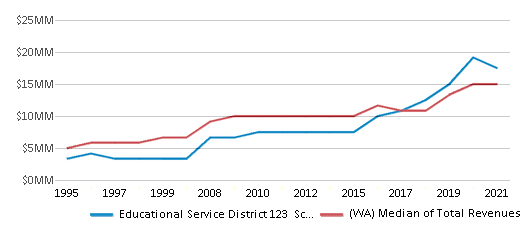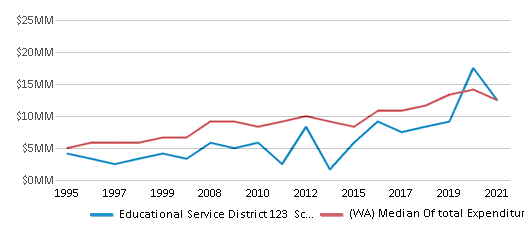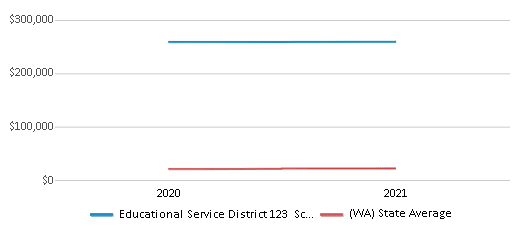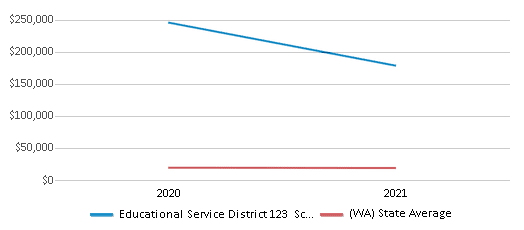For the 2025 school year, there is 1 public school serving 250 students in Educational Service District 123 School District.
Public Schools in Educational Service District 123 School District have a diversity score of 0.59, which is less than the Washington public school average of 0.69.
Minority enrollment is 60% of the student body (majority Hispanic), which is more than the Washington public school average of 52% (majority Hispanic).
Overview
This School District
This State (WA)
# Schools
1 School
2,565 Schools
# Students
250 Students
1,102,128 Students
# Teachers
n/a
62,276 Teachers
Student : Teacher Ratio
n/a
n/a
District Rank
The school district's graduation rate of 10% has decreased from 50% over five school years.
Students by Ethnicity:
Diversity Score
0.59
0.69
# American Indian Students
3 Students
14,077 Students
% American Indian Students
2%
1%
# Asian Students
1 Student
97,776 Students
% Asian Students
1%
9%
# Hispanic Students
127 Students
284,936 Students
% Hispanic Students
51%
26%
# Black Students
7 Students
52,278 Students
% Black Students
3%
5%
# White Students
100 Students
529,029 Students
% White Students
41%
48%
# Hawaiian Students
1 Student
15,943 Students
% Hawaiian Students
1%
2%
# Two or more races Students
2 Students
97,437 Students
% of Two or more races Students
1%
9%
Students by Grade:
# Students in PK Grade:
-
24,937
# Students in K Grade:
-
76,570
# Students in 1st Grade:
-
77,991
# Students in 2nd Grade:
-
81,918
# Students in 3rd Grade:
-
78,358
# Students in 4th Grade:
-
81,181
# Students in 5th Grade:
-
81,842
# Students in 6th Grade:
-
80,681
# Students in 7th Grade:
-
81,501
# Students in 8th Grade:
-
82,250
# Students in 9th Grade:
-
86,778
# Students in 10th Grade:
-
88,755
# Students in 11th Grade:
14
87,581
# Students in 12th Grade:
236
91,785
# Ungraded Students:
-
-
District Revenue and Spending
The revenue/student of $85,136 is higher than the state median of $18,796. The school district revenue/student has declined by 67% over four school years.
The school district's spending/student of $58,696 is higher than the state median of $19,246. The school district spending/student has declined by 67% over four school years.
Total Revenue
$21 MM
$20,715 MM

Spending
$15 MM
$21,212 MM

Revenue / Student
$85,136
$18,796

Spending / Student
$58,696
$19,246

Best Educational Service District 123 School District Public Schools (2025)
School
(Math and Reading Proficiency)
(Math and Reading Proficiency)
Location
Grades
Students
Rank: n/an/a
Ugrad Esd123 Re-engagement Program
Alternative School
3918 West Court Street
Pasco, WA 99301
(509) 544-5700
Pasco, WA 99301
(509) 544-5700
Grades: 9-12
| 250 students
Frequently Asked Questions
How many schools belong to Educational Service District 123 School District?
Educational Service District 123 School District manages 1 public schools serving 250 students.
What is the racial composition of students in Educational Service District 123 School District?
51% of Educational Service District 123 School District students are Hispanic, 41% of students are White, 3% of students are Black, 2% of students are American Indian, 1% of students are Asian, 1% of students are Hawaiian, and 1% of students are Two or more races.
What is Educational Service District 123 School District's spending/student ratio?
The school district's spending/student of $58,696 is higher than the state median of $19,246. The school district spending/student has declined by 67% over four school years.
Recent Articles

Year-Round Or Traditional Schedule?
Which is more appropriate for your child? A year-round attendance schedule or traditional schedule? We look at the pros and cons.

Why You Should Encourage Your Child to Join a Sports Team
Participating in team sports has a great many benefits for children, there is no doubt. In this article you will learn what those benefits are.

White Students are Now the Minority in U.S. Public Schools
Increasing birth rates among immigrant families from Asia and Central and South America, combined with lower birth rates among white families, means that for the first time in history, public school students in the United States are majority-minority. This shift in demographics poses difficulties for schools as they work to accommodate children of varying language abilities and socio-economic backgrounds.






